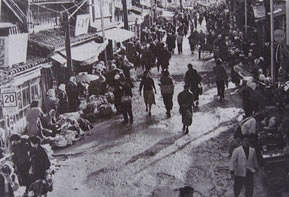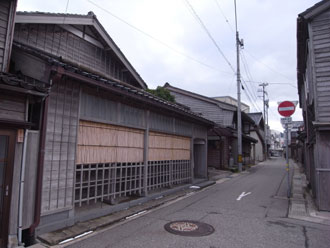

|
 |
In a series of ten articles under the heading of Noto: Unsung Treasures, the architect Shinji Takagi, who was born and raised in Wajima in Ishikawa prefecture, seeks to identify some of the interesting buildings and their background, old local customs and various pieces of engaging landscape, all of which might not make it into a tourist guide but are nevertheless of considerable interest. Wajima's Morning Market is still a major tourist attraction. Back in the mid-1950s, however, tourists had still not realized what a benefit it was, while the locals used it as their larder. Every morning the famous Ama divers would come to the market from the fishing district of town and the ladies farming smallholdings on Wajimazaki would bring fresh produce in from their fields to sell at the stalls lining the street where the market was held. Local housewives would soon be there with their shopping baskets to buy from the traders whose cries in the local dialect added to the atmosphere of the event. Their bags brimming with fresh goods, the shoppers would then go into the stores flanking the street behind the stalls to buy other essentials, and the stall holders, too, would become customers at these stores. The situation was ideal as both stall holders and store keepers benefitted from the way that the market was a focus of local production for local consumption. The market and the stores also provided somewhere for the stall holders to socialize, chat and to keep up with the latest news. And today the situation is more or less the same. As the market became more and more of a tourist attraction, the street was renamed Morning Market Street, although originally it was known to everyone as Honmachi Street. Then it was Wajima's main shopping street but previously it was where a number of true lacquer workshops were situated. Morning Market Street extends toward to the West for about 350 meters, with Honmachi Street making a dog-leg to the left into the Kawabata district. It then turns right into Okariya Street. It is here that the portable shrine used in the night-time summer festival is set down to give those carrying it a chance to catch their breath. Following the narrow street here we soon come to a place where we can see the mouth of the Wajima River. Although relatively unassuming, this short narrow street is lined with a few traditionally appointed buildings with slatted screen-work facades that even today give us an idea of how Wajima looked in the past. |
 
|
It is here that we find the Nurishi no Ie, a traditional building dedicated to the art and craft of true lacquer. It has the typical floor plan of a machiya, literally a “townhouse”. A passageway extends from the front entrance toward the back of the lot with living spaces opening off it; and with a storehouse and a workshop occupying the area furthest from the street. This particular building was erected soon after a devastating fire which destroyed most of the Kawai district in 1910. It is said to have been the prototype after which many similar premises in Wajima were modeled combining working and living accommodation for those engaged in true lacquerware production. The facade made up of a gabled-roof end and lean-to extension is relatively simple. Inside, however, the timber members of the linked spaces glow with a simple true lacquer finish, making it one of the best, most representative buildings of its type in Wajima. The big summer festival on Noto is the Kiriko matsuri. The tower-like floats of this well-known event are mostly finished with true lacquer and look particularly fine. Every summer on the 23rd August as part of the Yoi matsuri at the Juzo Shrine in the Kawai district, a really large and heavy portable shrine and Kiriko floats are taken down to the shore. Here they are paraded round and round what is known as the Ohtaimatsu―a high pole topped with foliage which is set alight. This is the dramatic climax of the festival, after which the floats are returned to their respective districts passing along the narrow Okariya Street. The shadows of the floats and all the people drifting by seen from inside the slatted screen-work of the Nurishi no Ie is a “performance” with its very own allure to round off the evening's proceedings. The sound of drumming becomes more and more distant and is mingled with the shrill tones of traditional flutes and brass dish-cymbals, all somehow hinting of the autumn to come. It is all part of the atmosphere evoked by the night-time sights and sounds of Wajima's summer festival. Sadly, however, the number of those willing to take part in this festival is falling year by year. Surely I am not the only one who hopes and dreams that one day, all the efforts of those who have fostered and supported the culture of true lacquer by traveling far and wide to promote it, will perhaps result in making Wajima the true lacquer capital of the world. If young people from all corners of the globe then come in search of what this remarkable material has to offer, then perhaps they will also be ready to take an active part in keeping the Kiriko festival alive. This will be my final article on the Unsung Treasures of the Noto Peninsula, although in truth, there are many other equally interesting places I would like to describe. Places of seemingly little consequence do, nevertheless, have a historical and cultural significance. A visit to any one of them will soon be proof of this fact. Why not come to Noto to look for your very own unsung treasures. You won't be disappointed. |
Shinji Takagi---Architect Born in Wajima in 1942. Worked on many projects using local materials and true lacquer for shops, houses and a variety of interior design schemes. Principal work includes Yuyado Sakamoto in Suzu: the repair and renovation of the true lacquer craftsman's house, Nurishi no Ie in Wajima: Meiso no Yakata in Toga, Toyama prefecture: the store Kombuya Shirai in Nanao and Kanazawa: a store selling Japanese candles, Takazawa Shoten in Nanao. Member on the Wajima City Council for the Protection of Cultural Properties Committee. Director of the NPO, Ishikawa Reed Thatch Culture Study Group. Bill Tingey---Translator Chief Designer to David Hicks in London before moving to Japan in 1976 and gaining a Masters Degree in History of Architecture. Worked in Japan as a photographer, designer, writer and translator. Returned to UK to continue work in 2000. |
| (2015/12 Yuko Yokoyama) |
|
(C)Copyright 2004 Jomon-sha Inc, All rights reserved. |